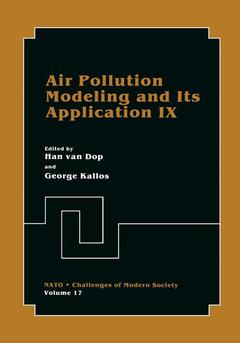Description
Air Pollution Modeling and Its Application IX, 1992
Nato Challenges of Modern Society Series, Vol. 17
Coordinators: Van Dop H., Kallos George
Language: English
Subjects for Air Pollution Modeling and Its Application IX:
Keywords
Air pollution; air quality; emission; policy; pollution; transport; weather; ecotoxicology
Publication date: 11-2012
803 p. · 17.8x25.4 cm · Paperback
803 p. · 17.8x25.4 cm · Paperback
Description
/li>Contents
/li>
The interest in air pollution modelling has shown substantial growth over the last five years. This was particularly evident by the increasing number of participants attending the NATO/CCMS International Technical Meetings on Air Pollution modelling and its Application. At the last meeting 118 papers and posters were selected from an abundance of submitted abstracts divided over five modelling topics: (i) model assessment and verification, including policy applications, (ii) air pollution modelling in coastal areas with emphasis on the mediterranean region, (iii) accidental atmospheric releases, including warning systems and regulations, (iv) modelling of global and long-range transport and (v) new developments in turbulent diffusion. A round-table discussion chaired by John Irwin (USA) and Jan Kretzschmar (Belgium) on the harmonization of air pollution models was attended by more than 50 scientists and is reported in these proceedings. The opening paper addressed the main issue of this conference: modelling over complex terrain. Of particular interest were coastal areas where the surface inhomogeneities introduce small-scale circulation and varying atmospheric stability, often combined with a complex topography. As the conference was located on the beautiful island of Crete, problems faced by the host nation, particularly Athens and its environs were obvious examples for consideration. These together with other regions with similar geographical features were addressed. Heavily populated and industrialized as they often are, air quality is generally poor there and emission regulations are desired. Obviously, a major task of air pollution dispersion modelling is to assist policy makers in formulating sensible regulations.
Model Assessment and Verification, Including Policy Implications: Air Quality Modeling in Complex Terrains; Y. Mahrer. U.K. Atmospheric Dispersion Modeling System; D.J. Carruthers, et al. Air Pollution Modeling in Coastal Areas with Emphasis on the Mediterranean Region: Weather Conditions During Air Pollution Episodes in Athens, Greece; G. Kallos, P. Kassomenos. Modeling of Photosmog Formations in Athens; N. Moussiopoulos, et al. Accidental Atmospheric Releases, Including Warning Systems and Regulations: Overview on ATMES; W. Klug. Modeling of Global and Long-Range Transport: Review of Numerical Approaches for Modeling Global Transport; D.L. Williamson. New Developments in Turbulent Diffusion: LargeEddy Simulation of Atmospheric Dispersion; P.J. Mason. Software/Video Presentations and Poster Session: Summary of Application Software Tracer Imager Package; W. Weiss, E. Reimer. 82 additional articles. Index.
© 2024 LAVOISIER S.A.S.




